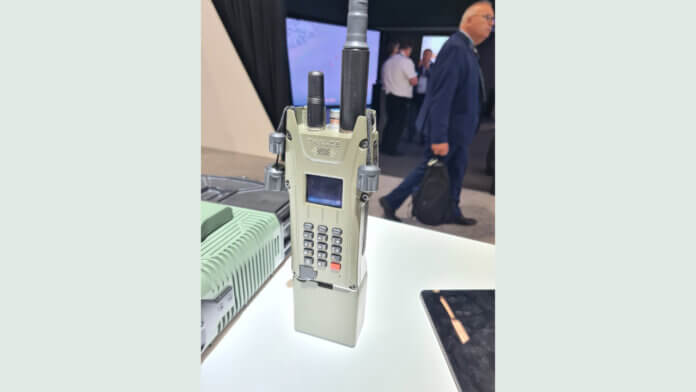
The French armed forces’ Contact programme is one of Europe’s most ambitious tactical communications renewals.
Thales is leading this programme rolling out new transceivers and waveforms across the country’s military. Armada was briefed on the programme’s latest developments at this year’s Eurosatory defence exhibition held in Paris between 13th and 17th June.
The Armée de Terre (French Army) receive the lion’s share of the new radios. The force will retire its venerable Thales PR4G Very/Ultra High Frequency (V/UHF: 30 megahertz/MHz to three gigahertz/GHz) radios. These will be replaced with new dual band 30MHz to 108MHz and 225MHz to 512MHz handheld and vehicular radios. The handheld radio is known officially as the ESRP (Equipement Radio Standard Portatif/Handheld Radio Terminal). The vehicular radio is officially designated the NCTT (Node de Communications Tactique – Terrestre/Land Tactical Communications Node). Interestingly, Contact does not include a backpack radio. Both the army and Thales told Armada that the ESRP comprises all the capabilities usually found in such a transceiver. An airborne radio (Contact-AR) is also in the offing. This will be rolled out across France’s fleet of military aircraft.
France’s Direction Générale de l’Armement (General Armaments Directorate) procurement agency awarded a contract to Thales to fulfill the programme in 2012. Development efforts took six years with production commencing in 2019. Open sources state that circa 25,000 radios across all types could be manufactured and delivered over ten years. Thales says that it will produce an average of 100 radios monthly, with one radio produced every two hours during the working day.
In June 2021, Contact radios were tested during the North Atlantic Treaty Organisation’s (NATO) Coalition Warrior Interoperability Exercise (CWIX). This allowed participating nations to test the interoperability of their communications systems and networks.
Waveforms
Contact radios will carry several waveforms. Importantly, from an interoperability perspective they will have the pan-European ESSOR (European Secure Software Defined Radio) waveform. ESSOR is discussed in more detail in our Testing Times article. French army sources told Armada that the ESRP and NCTT will both carry the French version of the waveform, known as ESSOR-VF. While ESSOR-VF will support multinational and coalition operations, the CONVERT waveform is for exclusive French use. Like ESSOR-VF this carries voice and data traffic.
Both new radios will be outfitted with a third waveform called Geomux. Launched in 2012, Geomux provides simultaneous voice, data and Blue Force Tracking (BFT) services. This is performed using two channels. The first carries voice and data. The second carries GNSS (Global Navigation Satellite System) derived BFT information. Geomux is also carried by the French Army’s PR4G radios. Having both families of radios carrying Geomux ensures they can communicate using this waveform. This will facilitate interoperability within the armed forces while the transition from legacy radios to new systems is ongoing. North Atlantic Treaty Organisation waveforms like SATURN (Second generation Anti-jam Tactical UHF Radio for NATO) will also be included. SATURN primarily carries air-to-surface/surface-to-air traffic.
An export variant of the Contact radio sans French national encryption and government waveforms is under development known as Synaps. Synaps will equip the Belgian armed forces. Spain will also receive the Synaps system with Indra and Thales collaborating on the acquisition. Having these armed forces use a similar radio system to Contact will enhance pan-European interoperability.
Into Service
Field testing of the Contact radios has been successfully completed. Army officials told Armada that the two Contact radios will enter service with the force by 2023. Deliveries will continue until the PR4G is phased out in circa 2025.
Contact forms part of a wider overhaul of French military radio communications. Beyond this programme, French troops will receive new Personal Role Radios (PRRs). These will replace Safran’s RIF-NG PRR equipping the force’s Fantassin à Équipement et Liaisons Intégrés (Integrated Infantryman Equipment and Communications) ensemble.
New High Frequency (HF: three to 30MHz) radios are also on the horizon. Army officials told Armada that several different types of HF radio are in service across France’s armed forces. Plans are afoot to harmonise these with a single radio type. These new radios will incorporate NATO’s Standardisation Agreement-4539 (STANAG-4539) Appendix-H. This prescribes the specifications for HF radio waveforms carrying between 72 kilobits-per-second/kbps and 144kbps of data. This is a significant step forward from the circa 9.6kbps prescribed by NATO’s current STANAG-4539 incarnation.
Contact is one of NATO’s most important military communications modernisation initiatives, not only because of the enhanced capabilities it provides France, but also via the inherent interoperability promised by ESSOR. Its’ progress will be watched with interest.
by Dr. Thomas Withington












